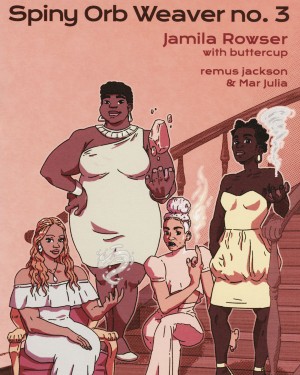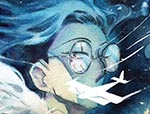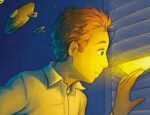With titles like Fizzle, Días De Consuelo and Spiny Orb Weaver, US comics micropublisher and distro Radiator Comics have already established themselves as champions of genuinely indie and socially relevant work. Their seventh publishing project is a print collection of buttercup’s compelling webcomic UM which is currently crowdfunding on Crowdfundr here. UM is described as “a magical girl comic about Eugenée, a Black, nonbinary, aspiring birth-worker who finds themself mixed up in a millennia-old conflict between the powers that be and a faction of cosmic, shamanic midwives.” We caught up with buttercup to talk about the comic’s themes, the challenges of bringing a webcomic to print, and the value of inspiring editorial input…

ANDY OLIVER: We have covered your work in the past at Broken Frontier when you contributed to Radiator Comics’ Spiny Orb Weaver series but for the benefit of readers new to your work could you tell us a little about your artistic background and your comics journey to date?
buttercup: I’m a self-taught animator, illustrator, and sequential artist, but everyone in my family has worked in the arts in some capacity going back generations. My earliest surviving drawings are attempts to draw Bruce Timm’s Batman and Superman, as well as characters from the Fox Kids’ ’90s Marvel shows. I started drawing and telling stories at a very young age and was casually introduced by relatives to both western comics and manga.
I published comics in my high school’s student-run newspaper and tried making longform comics a few times in my teens, but it wasn’t until 2014 that I began seriously adapting an epic poem I wrote titled ‘quandary’ into a comic. It eventually became UM. Over the years I’ve dabbled in different arts media both out of earnest interest and for survival, but Real Realm, the featured comic in the Spiny Orb Weaver issue you mentioned, and UM are my only ventures into comics publishing to date.

AO: UM is a comic that embodies the definition of cross-genre storytelling ranging from slice-of-life aspects to science fantasy, with a narrative set-up that feels genuinely distinctive. How would you describe that premise and the comic’s cast of characters to those discovering the comic for the first time via the crowdfunder?
buttercup: What you described initially is, to me, just what magical girl stories are. We initially see our protagonist Eugenée engaged in mundane activities—playing video games, feeding their plant, and talking to their cat—before the magical aspects of the world become apparent, and this is part and parcel with the magical girl genre. The initial slice-of-life approach lends itself to getting the audience acquainted with the characters in ways that traditional superhero or mystery comics might use narrative shorthand or massive text blocks to exposit. But because all of my characters are adults of marginalized identity, I felt meditating on the specifics of their day makes it easier to onboard readers into the more esoteric story elements later, sort of how in something like Sailor Moon the main character might be running—relatably—late to school and trip over a magical cat to kick things off, plot-wise.
The difference is Eugenée and our core cast of mostly Black protagonists are out of school, smoke weed, are already in a romantic polycule, and have very adult responsibilities to attend to, rather than having a typical magical girl protagonist’s disposition. Once things kick off, the story goes full anime combat sequence and resembles more of the standard superhero fare mainstream comics have primed us for. However—in keeping with the magical girl structure—the “battle” if you can call it that, is more of a puzzle or obstacle meant to be solved or overcome rather than an opponent meant to be defeated. We also get to see the diversity of responses the cast have to real, magical events happening before their eyes.
AO: As the crowdfunding campaign says, UM looks to capture “the essence of the storied history of resistance within the African Diaspora against global imperialism.” Can you elaborate on the themes you’re exploring in UM? And why do you think genre narrative and comics in particular are so effective in communicating important and socially relevant ideas to audiences?
buttercup: Criminalization of marginalized identity is something we’ve seen grow in tandem with the groundswell of anti-woke sentiments in recent years. All the characters in UM would likely be identified as “criminals” in the eyes of modern western conservatism just for existing. Mentally ill, substance-dependent, sexually active while unmarried, pagan, polyamorous, trans, Black, and upwardly mobile—each qualities that threaten the hegemony on some level. But the most obvious and central theme of the comic revolves around birth, and, by extension, recurrence.
Resistance takes time, and genre subsists on typology, so I’ve lightly sprinkled in hints toward a sort of archetypal and historical reincarnation and social evolution to explore the ideas of how change can happen, in juxtaposition against how it’s happened in the past. By placing the story within a tried and true genre format (i.e. magical girl), I can simply show the facts of queer Black life, without having to make any other political declarations. Genre is particularly good at providing a basic structure that can support potentially transgressive ideas if we’re cunning—rather than reductive—about where we place them.
AO: Radiator Comics are collecting the first few chapters of UM in print but, of course, it originally appeared as a webcomic. Given the very specific demands of webcomic delivery were there any changes or modifications you made to the original for the print version?
buttercup: Oh, definitely. Moreso because I’ve grown to understand my style preferences better over the past eight years, but I did start out by doing a-page-a-day just to combat my own ADHD and world building analysis paralysis. So a lot of the early pages as posted to Tapas are unrendered. The thing I was most excited about when Radiator Comics approached me was the prospect of updating the art to fit the style found in later chapters, so my editors and I dedicated a substantial amount of energy to updating the art, specifically for the early chapters, but in small ways throughout. We also strategized ways to make the story flow as seamlessly as possible, given that a lot of UM’s release was paced for webcomic publication, so there are a lot of new pages, like the ones explaining the lore and magic system, as well as the chapter-dividing spreads and splash pages.
AO: Your art on UM has an incredible fluidity, with page structures that tease, manipulate, and play with the traditional boundaries of the page. With that in mind can you give us some insights into your artistic process and the mediums you work in to bring the world of UM to life?
buttercup: As recently as 2018 I’d had a hard time finding my style preferences, but eventually landed on a clear fusion of some of my favorite comics and manga styles with a touch of classicist oil paint rendering. A lot of the comic is a reflection of this growth and finding my voice by emulating fellow comic artists like Choo and Ronald Wimberly.
If I mapped out my process it usually starts with me spending hours at a time quietly visualizing the events in my head—called “hyperphantasia”—as cuts in a film. Then once my vision of the story feels how I want, I explore what I visualized through a pencil-and-paper concept sketch and thumbnailing phase. Then I photograph the sketches and composite them in Clip Studio Paint. CSP provides a lot of automation and multimedia tools that manga artists have been using for years to simplify everything while retaining the artists style and personality. I think a lot of the fluidity of movement in UM comes from my background in film and the fact that I think more as an animator than as someone who’s fluent in comics’ grammar.
AO: Webcomics often allow creators a more immediate connection with their audience. How vital has that been to you in the development of UM and keeping you enthused about the story?
buttercup: Readership growth for UM has been slow, so the feedback isn’t very consistent. It doesn’t help that my update schedule is irregular. That being said, the small crowd of returning fans affirming their love of the work is very heartening for me. I definitely thrive on hyper specific, detailed, positive affirmation. Social media is a curse to be sure, but it’s undeniable that one of my biggest pleasures in life is the little dopamine hit I get when I see there are new comments on the comic and the readers are saying, “I’ve never seen anything like this before”. The real treasure though has been the materially supportive folks I’ve met along the way. I started a Patreon at the same time that I started publishing the comic, and that’s been an invaluable asset in my livelihood in the long-term.
AO: You worked with editors Jamila Rowser and Steenz on the project. How valuable were their contributions to the process?
buttercup: Absolutely invaluable. I worked with Jamila before on Real Realm for our Spiny Orb Weaver issue, but that was before the release of Wash Day Diaries. I was sure I wanted her feedback on the comic in a professional capacity but was legitimately worried she would be too busy to work on something so low profile. It’s not an exaggeration to say Jamila Rowser is one of my favorite living writers, period. Fortunately she said yes and accepted my suggestion that the duties be split as a disability accommodation for her chronic migraines and Long Covid symptoms.
My first choice for co-editor was Steenz. I wanted input from another nonbinary Black person familiar with the social and business side of comics and fluent in comics grammar. Suffice it to say there’s currently only a handful of editors in indie comics who fit that description. Steenz is direct, driven, and vocal about their opinion, and I think that’s the sort of guidance I needed to make the comic as strong as it could be. I’m excruciatingly grateful to both Jamila and Steenz for their willingness to work with me. Literally my dream team. Like, I’m tearing up right now thinking about it. You can viscerally feel how much more impactful the print version of the comic is compared to the webcomic, and that’s 100% thanks to them and their advisory role on this project.
AO: I imagine you’re incredibly busy with both the physical and digital versions of UM right now but are there any other upcoming projects you’re involved in, either in comics or outside, that you can tell us about?
buttercup: I recently illustrated the cover for an upcoming science fiction novella by T.T. (Temple) Madden titled The Cosmic Color coming out from Neon Hemlock Press. I did background designs and some animation on Daggerstarfighter’s Adult Swim bumper and there’s a pretty good chance we’ll be collaborating on something in the future. I livestream my work on UM via Twitch around 50 hours a week and release updates on Patreon two weeks before they go live on Comicfury. Besides that, just want to say thanks for having me, Andy!
Back the UM by buttercup crowdfunding campaign on Crowdfndr here
Interview by Andy Oliver




















